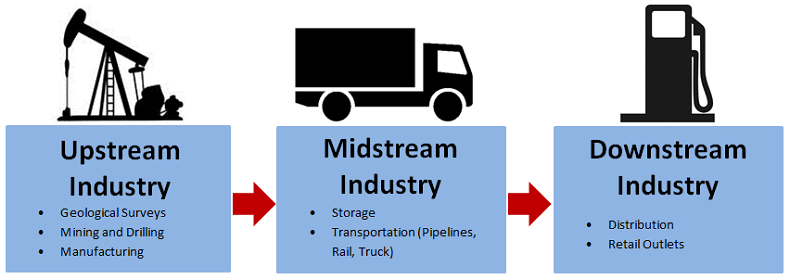Midstream oil and gas industry: Difference between revisions
m (1 revision imported) |
m (1 revision imported) |
||
| (One intermediate revision by one other user not shown) | |||
| Line 1: | Line 1: | ||
[[Category:Done | [[Category:Done 2020-01-31]] | ||
<onlyinclude>'''Midstream industry''' is the portion of the [[oil]] and [[natural gas]] industry that | <onlyinclude>'''Midstream industry''' is the portion of the [[oil]] and [[natural gas]] industry that processes, stores, and transports products such as [[crude oil]], [[natural gas]], [[liquefied natural gas|natural gas liquids]], and [[sulfur]].</onlyinclude><ref>PSAC. (June 11, 2015). ''Industry Overview'' [Online]. Available: http://www.psac.ca/business/industry-overview/</ref> Midstream industry is responsible for linking far-spread [[petroleum]] producing areas and population centers where consumers are located. Transmission [[pipeline]] companies are included in the midstream petroleum industry. In places like Canada with extensive [[oil sands]] extraction, the process of upgrading [[bitumen]] to [[synthetic crude]] is a part of midstream industry. | ||
[[File:oilind.png|400px|framed|center|Figure 1. Representation of [[upstream industry|upstream]], midstream, and [[downstream oil and gas industry|downstream]] industry.<ref>''Created internally by a member of the Energy Education team.''</ref>]] | [[File:oilind.png|400px|framed|center|Figure 1. Representation of [[upstream industry|upstream]], midstream, and [[downstream oil and gas industry|downstream]] industry.<ref>''Created internally by a member of the Energy Education team.''</ref>]] | ||
Latest revision as of 05:09, 31 January 2020
Midstream industry is the portion of the oil and natural gas industry that processes, stores, and transports products such as crude oil, natural gas, natural gas liquids, and sulfur.[1] Midstream industry is responsible for linking far-spread petroleum producing areas and population centers where consumers are located. Transmission pipeline companies are included in the midstream petroleum industry. In places like Canada with extensive oil sands extraction, the process of upgrading bitumen to synthetic crude is a part of midstream industry.
The different sectors included in midstream industry are:[3]
- Pipelines
- Transportation
- Upgraders and refineries
Environmental Impacts
There are several environmental impacts that can be connected to various midstream petroleum activities. The most apparent impacts are the ones associated with the transportation of goods. Since the midstream industry relies heavily on fossil fuels to transport oil and gas, there is an associated reduction in air quality and increase in greenhouse gas emissions. These greenhouse gas emissions include methane (the main component of natural gas) and carbon dioxide. There is also a higher risk of accidental leaks, spills, and explosions from pipelines, railroads, and ship tankers used to transport petroleum products that can harm the environment.[4] As well, the development of infrastructure necessary to make this possible disturbs wildlife habitats.
Interactive Graphs
For an interactive graph showing what pollutants arise from midstream oil industry click here. Note that on these graphs the midstream oil industry is actually called petroleum product transportation and distribution to remain consistent with what the data source provided. The values for emmisions can be compared emissions from downstream and upstream industry (they are actually quite small, comparatively). The pollutant being looked at is automatically set to sulfur oxides, but try changing the pollutant to nitrogen oxides, volatile organic compounds, or carbon monoxide!
For Further Reading
- Upstream oil and gas industry
- Downstream oil and gas industry
- Fossil fuel
- Oil refinery
- Greenhouse gas
- Or explore a random page
References
- ↑ PSAC. (June 11, 2015). Industry Overview [Online]. Available: http://www.psac.ca/business/industry-overview/
- ↑ Created internally by a member of the Energy Education team.
- ↑ Careers in Oil and Gas. (June 12, 2015). Midstream Petroleum Industry [Online]. Available: http://www.careersinoilandgas.com/build-your-career/about-the-industry/industry-overview/midstream-petroleum-industry.aspx#.VXrw389Viko
- ↑ Sustainability Accounting Standards Board. (June 12, 2015). Oil and Gas Midstream Research Brief [Online]. Available: http://www.sasb.org/wp-content/uploads/2014/06/NR0102_OG_Midstream_2014_06_24_Industry_Brief.pdf


